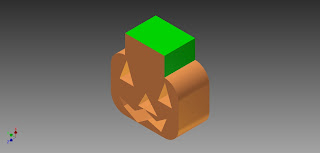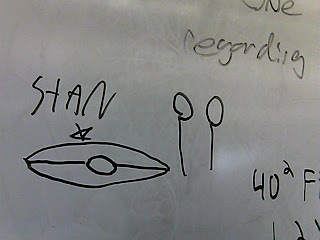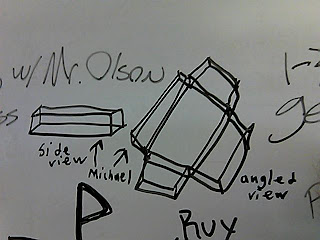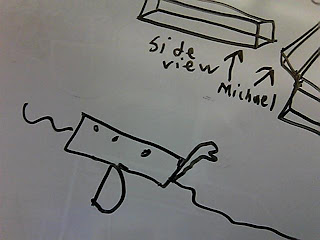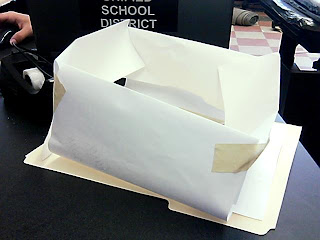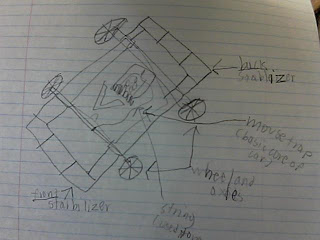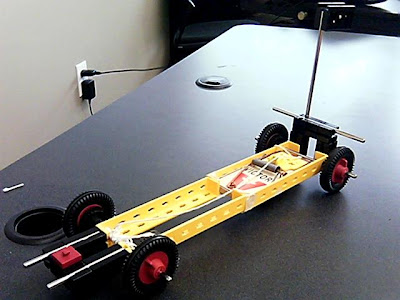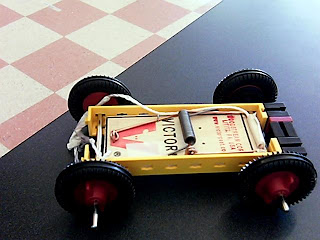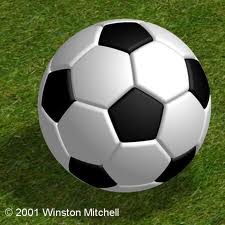This blog will consist of my interview with my dad whom had experience with engineering technology.
I received permission from Mr. Olson (my teacher) for interviewing my father, and I also received permission from my father for allowing me to interview him.
Here is some basic information about him:
Name: Michael J. Cox
Specific Degree: Bachelor of Science
Place of Employment: United States Navy
Contact Information: coxrocks50@hotmail.com
Here are the questions that I had asked him, and the responses that I got from my father about them.
Please describe your engineering field.
Gas-turbine engineering, he was the Chief Engineer for a guided missile frigate in the United States Navy. He was responsible for two LM2500 gas-turbine engines for primary propulsion and two diesel engines for auxiliary power. He also was also a gas turbine inspector for the Commander, Pacific Fleet's Propulsion Examining Board. He would fly all over the Pacific to Japan, Hawaii, and the West Coast Naval Bases to inspect the Engineering plants of all surface combatants. These included, carriers, cruisers, destroyers, and frigates.
What is your current job title?
He is a Commander in the United States Navy, and his designator is a Surface Warfare Officer.
Please describe your particular job and duties.
As the Chief Engineer, he was responsible for 75 engineers for the operation and maintenance of the ship. He and his engineers provided heat, electricity, propulsion, and fresh water for a crew of 350 people on the ship.
What is your average work schedule?
When his ship was in port, he would arrive at the ship at 6:00 A.M. and depart around 7:00 P.M. five to six days a week. When the ship was underway, he worked for 18 to 20 hours a day seven days a week. The ship was underway about 2/3rds of the time conducting operations and training for deployment.
Starting with high school, describe your educational background chronologically.
He took college focused AP and Honors classes like trigonometry, chemistry, and physics in high school. In college he took calculus, differential equations, electrical engineering, and chemistry. He received a masters degree in international business. After college he took various engineering courses with the navy.
If you had it to do over, related to your career or education, would you do anything differently?
He felt like that he was satisfied with his education and careers he took and wouldn't change a thing because each event that he took led to the next event and that greatly benefited him.
What advice would you give to me as someone interested in pursuing a career path similar to yours?
The advice he gave was to go to Naval Academy, or if I can't do that I should go to the Naval ROTC at another university.
Here are my reflections on my interview with my dad.
What surprised me the most in my interview with my dad was that he put in a ton of time when working at his ship when it is in port and underway.
The most important piece of information that I learned from this interview was that if I wanted to gain the same education on engineering then I know which classes to take like calculus and trigonometry, and where I should go to finish my education like the Naval Academy.
This interview has influenced my feelings about my future career by giving me an idea of what I might do with the engineering skills that I learned in courses and classes, and it gave me a great example of one part of the jobs that you can do that require skills in engineering.
Thursday, November 3, 2011
Tuesday, November 1, 2011
The Deep Dive
Wow, what a design.
I am impressed that a group of people were able to recreate an item like the shopping cart into a futuristic item. I would want to go shopping with one of those carts myself. It is amazing that we can remake anything we want, except for nature.
Here are my blog questions/answers
1. “From the buildings in which we live and work, to the cars we drive, or the knives and forks with which we eat, everything we use was designed to create some sort of marriage between ____form_____ and _____function_____.”
2. The folks at IDEO state that they are not experts in any given area. But, they do claim to be experts on the _____design process_____, which they apply to the innovation of consumer products.
3. After the team of designers is brought together, told the problem, and informed they have five days to “pull it off,” what phase of the design process do they immediately engage in?
The phase of the design process that they immediately engage in is the Brainstorming Phase when they were brought together, told the problem, and are told that they had a five day deadline.
4. Give two examples of what the team members did during this phase.
a. They went to the supermarket and observed the shopping carts in action.
b. The group generated a list of ideas that they posted on the wall, and voted for the best design to build.
5. List five rules-of-thumb that IDEO employees follow when they share ideas during the brainstorming phase:
a. One conversation at a time.
b. Stay focused on the topic.
c. Encourage wild ideas.
d. Defer judgement.
e. Build on the ideas of others.
6. Why should wild (and sometimes crazy) ideas be entertained during the brainstorming phase?
Wild and crazy ideas should be entertained during the brainstorming phase because it allows the design group to branch out and build on the idea, while plain and simple ideas are hard to branch and build upon.
7. After the brainstorming phase was over, the team narrowed down the hundreds of ideas by ___voting___ for those ideas that were not only “cool” but also _______buildable__________ in a short period of time. What phase of the design process is this called?
This part of the design phase is the Select an Approach Phase because the group was selecting one design out of hundreds of ideas.
8. IDEO believes that the ideas and efforts of a ___group___ will always be more successful than the planning of a lone genius.
9. Once the ideas were narrowed down and divided into categories, the group was split into four smaller teams. What phase(s) of the design process was each of these groups responsible for?
The phases of the design process that each group was responsible for using were Identify Criteria and Specify Constraints, Explore Possibilities, and Make a Model or Prototype.
10. The leaders at IDEO believe that __chaotic__ behavior and a __creative__ environment are two important reasons why their employees are able to think quickly and creatively to produce innovative results.
11. Sometimes, people come up with great solutions that work by trying their ideas first, and asking for ________permission_________ later.
12. Design is often a process of going too far and having to take a few steps back. What phase of the design process would the critique of the four mock-ups come under?
The phase of the design process that would critique the four mock-ups is to Test and Evaluate the Design using Specifications.
13. Upon critique of the four teams’ models, it was obvious that none of the teams had developed an optimum solution. However, the people at IDEO believe that it is important to ___fail___ often in order to ___succeed___ sooner.
14. What percentage of the entire week’s time did it take to fabricate the final prototype?
It took about 40% of the time needed during the week to complete the final prototype.
15. Instead of showering his design team with a tremendous amount of praise, what did the boss require his employees to do with their new design?
The boss required that the employees take the finished design to the supermarket to test the design out.
16. Of all the things that we are surrounded by every day, what has not been placed through the design process?
The only thing that has not been placed through the design process out of all the things that we are surrounded by everyday is nature.
Conclusion
1. What did you find to be the most impressive part of the team’s effort?
What I found to be the most impressive part of the team's effort was that they would work day and night to complete their product, and I also find it impressive that they are able to work better under chaotic behavior and a creative enviroement.
2. What advantages are there to having a design team with members that have non-engineering backgrounds?
The advantages of having a design team with members that have non-enginerring backgrounds is that it allows for more wild ideas to be created and built upon, and they could use their own background to contribute a new approach to the general project.
3. There was a point in the process where a self-appointed group of adults stepped up, stopped the ideas, and redirected the group to break up into teams. Why was this done?
The group of self-appointed adults stepped up, stopped the ideas, and redirected the goup to break into teams becasue they feared that under a time constraint that they wouldn't get the job done in time with the group voting on designs, and that by spliting into teams the group has a better chance of getting the job done under the five-day time constraint.
4. At the end of the video, Dave Kelly states, “Look around. The only things that are not designed are the things we find in nature.” Can you think of anything that would contradict this statement?
I think that there are more items that can't undergo the design process in outer space. For example, we can't recreate the sun in a different way, we can't recreate gravity in another way, and we can't recreate black holes or supernovas whenever we want to.
I am impressed that a group of people were able to recreate an item like the shopping cart into a futuristic item. I would want to go shopping with one of those carts myself. It is amazing that we can remake anything we want, except for nature.
Here are my blog questions/answers
1. “From the buildings in which we live and work, to the cars we drive, or the knives and forks with which we eat, everything we use was designed to create some sort of marriage between ____form_____ and _____function_____.”
2. The folks at IDEO state that they are not experts in any given area. But, they do claim to be experts on the _____design process_____, which they apply to the innovation of consumer products.
3. After the team of designers is brought together, told the problem, and informed they have five days to “pull it off,” what phase of the design process do they immediately engage in?
The phase of the design process that they immediately engage in is the Brainstorming Phase when they were brought together, told the problem, and are told that they had a five day deadline.
4. Give two examples of what the team members did during this phase.
a. They went to the supermarket and observed the shopping carts in action.
b. The group generated a list of ideas that they posted on the wall, and voted for the best design to build.
5. List five rules-of-thumb that IDEO employees follow when they share ideas during the brainstorming phase:
a. One conversation at a time.
b. Stay focused on the topic.
c. Encourage wild ideas.
d. Defer judgement.
e. Build on the ideas of others.
6. Why should wild (and sometimes crazy) ideas be entertained during the brainstorming phase?
Wild and crazy ideas should be entertained during the brainstorming phase because it allows the design group to branch out and build on the idea, while plain and simple ideas are hard to branch and build upon.
7. After the brainstorming phase was over, the team narrowed down the hundreds of ideas by ___voting___ for those ideas that were not only “cool” but also _______buildable__________ in a short period of time. What phase of the design process is this called?
This part of the design phase is the Select an Approach Phase because the group was selecting one design out of hundreds of ideas.
8. IDEO believes that the ideas and efforts of a ___group___ will always be more successful than the planning of a lone genius.
9. Once the ideas were narrowed down and divided into categories, the group was split into four smaller teams. What phase(s) of the design process was each of these groups responsible for?
The phases of the design process that each group was responsible for using were Identify Criteria and Specify Constraints, Explore Possibilities, and Make a Model or Prototype.
10. The leaders at IDEO believe that __chaotic__ behavior and a __creative__ environment are two important reasons why their employees are able to think quickly and creatively to produce innovative results.
11. Sometimes, people come up with great solutions that work by trying their ideas first, and asking for ________permission_________ later.
12. Design is often a process of going too far and having to take a few steps back. What phase of the design process would the critique of the four mock-ups come under?
The phase of the design process that would critique the four mock-ups is to Test and Evaluate the Design using Specifications.
13. Upon critique of the four teams’ models, it was obvious that none of the teams had developed an optimum solution. However, the people at IDEO believe that it is important to ___fail___ often in order to ___succeed___ sooner.
14. What percentage of the entire week’s time did it take to fabricate the final prototype?
It took about 40% of the time needed during the week to complete the final prototype.
15. Instead of showering his design team with a tremendous amount of praise, what did the boss require his employees to do with their new design?
The boss required that the employees take the finished design to the supermarket to test the design out.
16. Of all the things that we are surrounded by every day, what has not been placed through the design process?
The only thing that has not been placed through the design process out of all the things that we are surrounded by everyday is nature.
Conclusion
1. What did you find to be the most impressive part of the team’s effort?
What I found to be the most impressive part of the team's effort was that they would work day and night to complete their product, and I also find it impressive that they are able to work better under chaotic behavior and a creative enviroement.
2. What advantages are there to having a design team with members that have non-engineering backgrounds?
The advantages of having a design team with members that have non-enginerring backgrounds is that it allows for more wild ideas to be created and built upon, and they could use their own background to contribute a new approach to the general project.
3. There was a point in the process where a self-appointed group of adults stepped up, stopped the ideas, and redirected the group to break up into teams. Why was this done?
The group of self-appointed adults stepped up, stopped the ideas, and redirected the goup to break into teams becasue they feared that under a time constraint that they wouldn't get the job done in time with the group voting on designs, and that by spliting into teams the group has a better chance of getting the job done under the five-day time constraint.
4. At the end of the video, Dave Kelly states, “Look around. The only things that are not designed are the things we find in nature.” Can you think of anything that would contradict this statement?
I think that there are more items that can't undergo the design process in outer space. For example, we can't recreate the sun in a different way, we can't recreate gravity in another way, and we can't recreate black holes or supernovas whenever we want to.
Monday, October 31, 2011
Halloween Blog
Hey everyone,
Happy Halloween! I would like to show the pumpkin that I made today in class using a special art program.
Pretty cool huh.
Happy Halloween! I would like to show the pumpkin that I made today in class using a special art program.
Pretty cool huh.
Thursday, October 27, 2011
Energy Sources
Hello everyone
We just completed and presented our energy sources project. There are nine energy sources in total, and all nine energy sources were split among the class. I got the energy source, coal, and I created a PowerPoint presentation that talks about coal and its usefulness in energy production.
Here is my PowerPoint presentation:
Energy Source Questions:
1. Describe one thing that surprised you about the energy source that you researched and presented.
One thing that surprised me about coal while I researched and presented it is how it is one of the most (if not the most) used energy sources in the world, and that about 30% is actually used efficiently.
2. Describe one thing that surprised you about an energy source that another team presented.
An energy source that was presented today that surprised me was hydro power because it is one of the oldest energy sources in the world, and that it is generally about 50% effective at creating energy.
3. Describe and defend what you believe to be the most important technological need regarding energy.
I think that the most important technological need regarding energy is solar power. It is a renewable energy because the sun will never go away, and that it is endlessly giving off solar energy that is drastically more beneficial to the planet than the use of oil or nuclear energy.
We just completed and presented our energy sources project. There are nine energy sources in total, and all nine energy sources were split among the class. I got the energy source, coal, and I created a PowerPoint presentation that talks about coal and its usefulness in energy production.
Here is my PowerPoint presentation:
Energy Source Questions:
1. Describe one thing that surprised you about the energy source that you researched and presented.
One thing that surprised me about coal while I researched and presented it is how it is one of the most (if not the most) used energy sources in the world, and that about 30% is actually used efficiently.
2. Describe one thing that surprised you about an energy source that another team presented.
An energy source that was presented today that surprised me was hydro power because it is one of the oldest energy sources in the world, and that it is generally about 50% effective at creating energy.
3. Describe and defend what you believe to be the most important technological need regarding energy.
I think that the most important technological need regarding energy is solar power. It is a renewable energy because the sun will never go away, and that it is endlessly giving off solar energy that is drastically more beneficial to the planet than the use of oil or nuclear energy.
Tuesday, October 4, 2011
Emergency Preparedness Supply List
A couple of Thursdays ago, the entire Southwestern U.S. underwent a huge blackout, and many residents weren't prepared for such an event. A crisis like this tells us that we must be prepared for events like this in the future.
Define the Problem:
Three emergencies that my family and I would need supplies for are:
20 supplies that I could use for those emergencies are:
Define the Problem:
Three emergencies that my family and I would need supplies for are:
- Fire
- Tsunami
- Earthquakes
20 supplies that I could use for those emergencies are:
- food
- water
- clothing
- money
- candles
- flashlights
- dust mask
- watch
- radio
- television
- spare batteries (Stanley)
- important documents
- whistle
- medicine
- inflatable raft
- knife
- cellphone
- cellphone charger
- passports
- first-aid kit
Generate a Solution:
A list of items that I can use in emergencies that are affordable for my family and I are:
Ideas(!) - I could add ID's and credit cards so that we can purchase other supplies. A pocketknife, toiletries, and activity items to make the experience in the emergency more tolerable. I could also add stuff like blankets or medicine to take care of anyone who was sick. Basically imagine yourself in the situation and think about what you would really need. (My dad)
- food
- water
- clothing
- money
- spare batteries
- flashlights
- radio
- watch
- first-aid kit
- candles
- important documents
- passports
Solicit Feedback:
Any feedback, +(positive), ∆(change), ?(questions), or !(idea) from my family.
Positive(+) - The list that I made was great and that my choices for my list were agreeably necessary yet affordable. (My dad)
Changes(∆) - The list is good, but there are more items that are affordable yet necessary that I can add. (My dad)
Question(?) - What other items could I add to the list that are affordable yet necessary at the same time, and is there anything that I need to take out of my list? (My dad)
Positive(+) - The list that I made was great and that my choices for my list were agreeably necessary yet affordable. (My dad)
Changes(∆) - The list is good, but there are more items that are affordable yet necessary that I can add. (My dad)
Question(?) - What other items could I add to the list that are affordable yet necessary at the same time, and is there anything that I need to take out of my list? (My dad)
Ideas(!) - I could add ID's and credit cards so that we can purchase other supplies. A pocketknife, toiletries, and activity items to make the experience in the emergency more tolerable. I could also add stuff like blankets or medicine to take care of anyone who was sick. Basically imagine yourself in the situation and think about what you would really need. (My dad)
Refine your Solution:
I have added more and changed my emergency supply list.
The key to the list is:
+ = (positive)
∆ = (changes)
? = (questions)
! = (ideas)
I have added more and changed my emergency supply list.
The key to the list is:
+ = (positive)
∆ = (changes)
? = (questions)
! = (ideas)
- food (+)
- water (+)
- clothing (+)
- money (+)
- spare batteries (+)
- flashlights (+)
- radio (+)
- candles (?)
- watch (+)
- analog telephone (∆)
- important documents (+)
- passports (+)
- ID's (!)
- credit cards (!)
- toiletries (!)
- first-aid kit (+)
- medicine (!)
- pocketknife (!)
- whistle (∆)
- blankets (!)
- heavy gloves (∆)
- heavy shoes (∆)
- activity items (!)
Rules of the Road
Hello everybody!
Wasn't that a fun race with the mousetraps!
Here are some of my ideas to make the race more interesting.
Wasn't that a fun race with the mousetraps!
Here are some of my ideas to make the race more interesting.
- The mousetrap must be part of the car
- You must use string to power the car
- The car can't be launched
- The mousetrap must power the car
- 4 wheels and two axles must be used for the car
Cardboard Challenge
Hello everybody,
We've had just had an amazing time with the cardboard racing in the 2nd Annual Cardboard Canoe Challenge at Coronado High School. Our team "Los Zapatos" created a cardboard boat, "the bedboat, as I call it," and we were able to complete the race with second place becuase our speed was pretty good but not great. However it was enough to pull us through as the boat that went the 2nd fastest and the 2nd longest distance covered, and we were able to stay afloat for a long period of time.
In this challenge I earned a total of 13 achievements from completing the challenge.
Define the Problem and Brainstorm Solutions Achievement:
The problem we had to solve was that we had to make a boat out of cardboard that will be able to carry at least one CHS student across the water in the pool without sinking.
20 ideas that I have had regarding my solution were:
1. create a raft
2. a canoe
3. an ideal-shaped boat
4. use oars with boat
5. use rope to pull boat across water
6. swimmer pulls boat across the water
7. bake the boat flat for effective stability
8. use high walls to prevent incoming water
9. use duct tape to cover holes in cardboard
10. have the boat have be equal in surface area and volume
11. use lots of cardboard for the base to prevent internal colapse in water
12. make a submarine boat
13. make a head of a fictional creature on the boat like the Vikings
14. Have a flag on the boat
15. The boat must carry the lightest weighed person for a less chance of sinking
16. The boat needs to be fast yet stable on water
17. The boat must be able to stay afloat for a long period of time
18. The boat needs to be build evenly to prevent capsizing
19. Must be able to use boat more than once on the water
20.Boat needs to be strong enough to carry one person
Criteria and Constraints Achievement:
Criteria and constraints are both used to regulate the rules and restrictions of regular competition.
One criteria is that the boat needs to carry at least one person throughout the competition.
Three constraints are:
You can only use duct tape and cardbaord for the event
All exposed cardboard must be covered by duct tape
The instructor must approve the type of cardboard before it is used for the boat
One criteria is that the boat needs to carry at least one person throughout the competition.
Three constraints are:
You can only use duct tape and cardbaord for the event
All exposed cardboard must be covered by duct tape
The instructor must approve the type of cardboard before it is used for the boat
Sketch Ideas Achievement:
These 3 pictures are our brainstorms on how we should build the cardboard boat.
1st sketch:
This boat has the shape of a canoe, and this shape will provide great speed
The oars on the side are going to be used to power the canoe across the water
The long shape of the canoe will allow the boat to go at a great distance and speed, but takes away a little stability
2nd sketch:This boat will be in a box shape to ensure stability from all sides of the boat
The sides of the boat will be tall enough to prevent incoming water from getting into the boat
The box-like boat will provide great stability, floatability, and average speed for getting across the pool
This boat will resemble a viking boat with a good height of cardboard wall to prevent incoming water
The front of the boat will have a mermaid or dragon head for decoration and frontal stability
The wings of this boat will prevent the boat from capsizing because they provide extra stability on the water
Prototype Ideas Achievement:
Here are our prototypes of each of our sketches that I posted up above.
Each will go in order of the sketches above.
1st prototype:
This canoe-like prototype has the advantage of the skiffs for extra stability and also contains oars for speed.
2nd prototype:
The box shape of this prototype will allow average speed, but has a good surface area to achieve maximum floatability.
3rd prototype:

This boat-like prototype will allow a good amount of speed with the long length and long bow (front), while achieving a good amount of floatability with an average amount of surface area.
Select an Approach Achievement:
I have gained feedback from each of the three designs that I posted above.
Note: each feedback will go in order from top to bottom prototypes that are posted above.
1st prototype feedback:
Positive: The use of the side skiffs will help in stability and the use of oars will benefit the boat in speed.
Change: The walls of the boat are a little small and water can easily get in, and the inclusion of the side skiffs can lead to a risk in balance if not built proportionately.
Questions: How can we make it so that the walls can be built higher, yet be able to build and attach the side skiffs effectively?
Ideas: We can solve the problem by attaching two support beams per side skiff on the upper and lower parts of the higher wall, and this will allow good balance while preventing water from coming in.
2nd prototype feedback:
Positive: The box-like prototype will allow for excellent stability and durability because of the high walls.
Change: The prototype is only able to go at an average speed because of the large amount of surface area and volume contributed to the boat.
Questions: How can we make the prototype go faster on water in the race without changing the height of the walls?
Ideas: For the race we will have someone pull the boat across the water with a rope like substance, and this will help gain the speed the boat needs without changing the structure a lot.
3rd prototype feedback:
Positive: The shape of the boat will offer a good amount of speed, stability, and durability for the race that will take place because of a protruding front.
Change: The boat could be a little off balance because of the protruding front, and could potentially capsize the boat.
Questions: How can we fix the boat so that we can evenly balance it with the protruding front.
Ideas: The problem can be fixed by either shortening the length of the front, or by making the back equally extended out like the front to ensure balance that way.
Decision Matrix:
Each prototype will be graded on account of floatability, stability, and durability (floatability = how well the boat floats, stability = how stable and secure is the boat, and durability = how strong is the boat).
Each grade will be from 1-10 (1 being the lowest and 10 being the highest), and each prototype is identified with the order of the photos above from top to bottom (the top photo = prototype 1, middle photo = prototype 2, and bottom photo = prototype 3) Each of the three scores will be added in the end for a total score for the prototype (ranges from 3 to 30)
Prototype 1:
Floatability = 6
Stability = 9
Durability = 5
Total = 20
Prototype 2:
Floatability = 9
Stability = 9
Durability = 10
Total = 28
Prototype 3:
Floatability = 8
Stability = 9
Durability = 8
Total = 25
My group went along with Prototype No. 2 because it is the highest total score of the three prototypes, and that it has the highest chance of success out of the other two prototypes for being effective in the water race in the pool.
Build It! Achievement:
We built the canoe, and we did enter the race with it; unfortunately we were unable to get a picture of it when it was fully complete and ready for action. Our boat generally looked like the prototype #2's picture above, but the wall in the front was lowered and the back was raised slightly; giving the boat a sort of bed-like image.
The Longest Achievement:
Our group came in second for both the race and distance challenges, however we were able to stay afloat during the challenges and for a while longer. It only completely sank in the end when four people jumped into the boat.
Feedback Achievement:
We finished the boat race in the pool, and our boat did alright in the water challenges. Here is some feedback of our boat now that my team has tested it out. (Positive = +)(Change = ∆)(Questions = ?)(Ideas = !)
1. The boat was well built in balance and stability (+)
2. The swimmer was crucial in giving the boat the necessary speed it needed (!)
3. The boat was covered well with duct tape, with only one or so leaks (+)
4. The boat was able to carry myself in the water when I rode it (+)
5. The boat sagged a little when someone a little bigger than myself rode it (∆)
6. There was no other way to actually move the boat efficiently without the swimmer (?)
7. The swimmer was able to get the boat from one side of the pool to another (!)
8. The boat was durable against any kind of collision with another object or thing (+)
9. The boat was slowly falling apart after a while due to a few leaks after using the boat (∆)
10. The boat was able to still stay afloat even with the leak due to putting a large amount of cardboard down as the base of the boat (+)
How Low Did You Go Achievement:
Our team's boat sat roughly about 5 inches into the water during the race and other water challenges. I was surprised that the boat only went down a little bit after getting inside it, but I was pleased because this meant that the boat was well constructed against water going into the boat. The unit weight of water is 8.3454 pounds per gallon. The pilot (myself) weighed about 158 pounds. Our boat weighed about 8 pounds, and that weight added to my approximate weight equals about 166 pounds that entered the water. Since water is about 8 pounds per gallon, 166 divided by 8 equals about 20.75 pounds that went into the water. I would guess that from there it is about 10 or so inches that went into the water.
Redesign Achievement:
If we were to do another cardboard canoe race next semester, I would go with the exact, same design that we used for this challenge; with the addition of putting on more duct tape on the bottom. A picture of the design that we will use next year looks like this (unfortunately everything has been mirrored, so I will translate it for you.):
This picture shows the boats that were built for this canoe challenge.
The top right says that it is a raft and the length is 5 ft, the height is 1/2 ft, and the width is 3 ft.
The top left says that it is an original boat (a stereotypical boat), and the length is 7 ft, the width is 2 ft, and the height is 3 ft.
The bottom says that is is a bed-like boat, and the length and width are 5 ft, and the height are 3 ft in the front, and 4 ft in the back.
This picture shows the most competitive solution that will be the most useful in winning the next canoe race, and for height it is 3 ft in the front and 4 ft in the back, for length it is 5 ft, and for width it is 2 ft.
Maximum Capacity Achievement:
This is one of the achievements that I made up, basically it requires you to find out how many people can fit into your boat until it completely sinks. We were able to get four people into the boat before it sank completely.
Patriotic Achievement:
This is one of the achievements that I made up, basically it requires you to put something on the boat that symbolizes the nation in some way. On our boat, we put an American flag on the front of the boat, and we kept it on throughout the race and water challenges. We took the flag off in the end when the boat was "decommissioned."
Nickname Achievement:
This is one of the achievements that I made up, basically it requires you to make up a creative name that is appropriate to the boat. I nicknamed the boat, "the bed-boat" because of its bed like structure and image.
Monday, September 26, 2011
Simple Machine Challenge part I
I earned a total of 11 Achievements on this challenge.
The "Brainiac" Achievement
Here are 10 ideas I brainstormed for my design:
1. The race car must have a chain.
2. The mousetrap must be the core component of the car.
3. The mousetrap must stay on and part of the car.
4. The race car must use the simple machine of wheel an axle for mobility.
5. String must be used to make the car move.
6. At least one chain must be used to power the car.
7. Small wheels must be used for mobility.
8. Large wheels and gears must be used to power car as well.
9. The race car must be small for maximum mobility effect.
10. The race car must also look like an ideal race car (flag).
The "Visualize It" Achievement
Here is a sketch of my original design of my race car.
The "Build It!" Achievement
Here's a photo of the race car that I constructed:
The "Price of Glory" Achievement
If each part used in my design cost $1, the total cost of my build would be $38.
I have 38 parts in my car.
The "Competitor" Achievement
I have entered my race car in the 2nd Annual Mousetrap Racecar Challenge
The "Feedback" Achievement
My race car is well put-together and the winding of the string is a good way to power the car. I had my car changed to include less weight and more stability and speed by taking off uneccesary parts needed to power the car. My questions were how to make the car speed up and how to make it stable enough that it can go over long distances. I then thought of the idea that I was using too much string, and that my car was too long and unstable.
The "Re-Work" Achievement
I changed my design of my car by making it shorter, and trading weight for speed by decreasing the amount of parts.
Here is a picture of my race car now.
The "Game Changer" Achievement
My new rule for this game is to have the mousetrap as the core component of the race car like an engine of a real car. The mouse trap is the main mechanism that is powering the car, so in my opinion it is the engine of the car, and that this will change the ideas of car designing for future races.
The "Name It" Achievement
I invented the "Ideal Race Car" Acievement where the car looks the most idential to an ideal race car.
The "Leave It Cleaner Than You Found It " Achievement
The area that I used for making my race car had no loose parts lying around. I made sure that I used all the pieces I had available, and for the ones that I didn't use I put away.
The "Design/Build" Achievement
The Design/Build process is when the contractor and the builder are in the same group as opposed by the regular build process when the contractor and the builder are in completely different groups. I used the design/build process to create a blueprint for the car like a contractor and at the same time I built the race car like the builder as one job. I might experience this process in technical innovation because a unified group will work faster and more effeciently to make things with the design/build process, and separate groups will get the job done but at a slower pace with the regular building process.
The "Brainiac" Achievement
Here are 10 ideas I brainstormed for my design:
1. The race car must have a chain.
2. The mousetrap must be the core component of the car.
3. The mousetrap must stay on and part of the car.
4. The race car must use the simple machine of wheel an axle for mobility.
5. String must be used to make the car move.
6. At least one chain must be used to power the car.
7. Small wheels must be used for mobility.
8. Large wheels and gears must be used to power car as well.
9. The race car must be small for maximum mobility effect.
10. The race car must also look like an ideal race car (flag).
The "Visualize It" Achievement
Here is a sketch of my original design of my race car.
The "Build It!" Achievement
Here's a photo of the race car that I constructed:
The "Price of Glory" Achievement
If each part used in my design cost $1, the total cost of my build would be $38.
I have 38 parts in my car.
The "Competitor" Achievement
I have entered my race car in the 2nd Annual Mousetrap Racecar Challenge
The "Feedback" Achievement
My race car is well put-together and the winding of the string is a good way to power the car. I had my car changed to include less weight and more stability and speed by taking off uneccesary parts needed to power the car. My questions were how to make the car speed up and how to make it stable enough that it can go over long distances. I then thought of the idea that I was using too much string, and that my car was too long and unstable.
The "Re-Work" Achievement
I changed my design of my car by making it shorter, and trading weight for speed by decreasing the amount of parts.
Here is a picture of my race car now.
The "Game Changer" Achievement
My new rule for this game is to have the mousetrap as the core component of the race car like an engine of a real car. The mouse trap is the main mechanism that is powering the car, so in my opinion it is the engine of the car, and that this will change the ideas of car designing for future races.
The "Name It" Achievement
I invented the "Ideal Race Car" Acievement where the car looks the most idential to an ideal race car.
The "Leave It Cleaner Than You Found It " Achievement
The area that I used for making my race car had no loose parts lying around. I made sure that I used all the pieces I had available, and for the ones that I didn't use I put away.
The "Design/Build" Achievement
The Design/Build process is when the contractor and the builder are in the same group as opposed by the regular build process when the contractor and the builder are in completely different groups. I used the design/build process to create a blueprint for the car like a contractor and at the same time I built the race car like the builder as one job. I might experience this process in technical innovation because a unified group will work faster and more effeciently to make things with the design/build process, and separate groups will get the job done but at a slower pace with the regular building process.
Tuesday, September 13, 2011
My First Blog Post!
Welcome one and all to those who visit my blog. It is a place where people will post random stuff that goes on with their day. However, I don't put random stuff in my blog, I put in importantce and stuff that I will probably use in life that I don't currently know about yet. I like the sport of football or as we Americans call it, soccer.
If you look up from here or down from the text above, you will find the humble picture of a soccer ball.
Enjoy the rest of the blog world
Subscribe to:
Posts (Atom)
